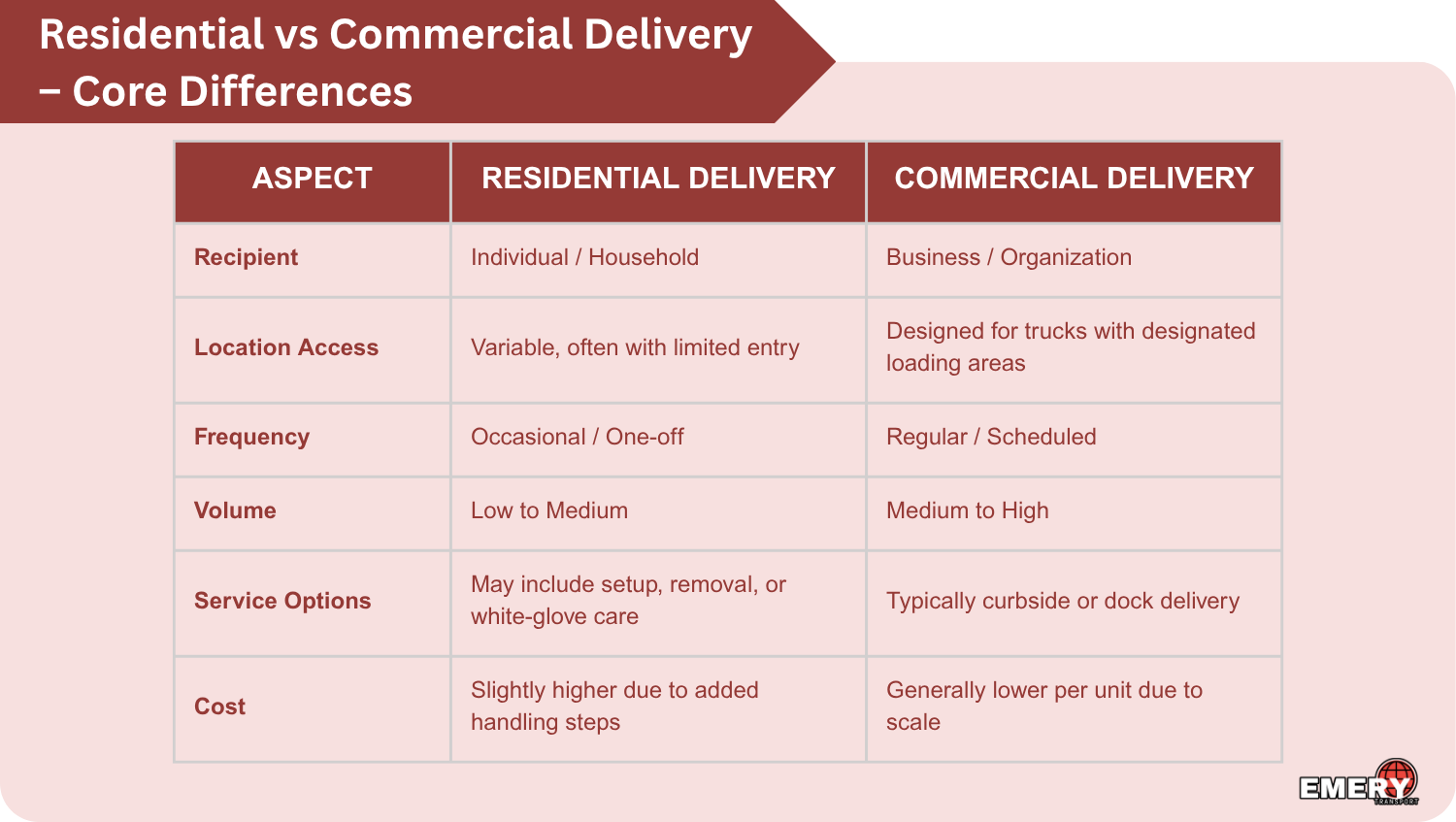When selecting a delivery service, understanding the distinction between residential and commercial delivery is crucial for both businesses and individuals. Both serve different purposes, require varied logistics, and often follow separate pricing and handling models. Emery Transport, a trusted leader in logistics, offers both residential and commercial delivery services tailored to meet the specific needs of each client.
To help you make informed decisions for your shipping or delivery needs, let’s break down the fundamental differences between these two service types.
Understanding Residential Delivery Services
Residential delivery refers to the transportation of goods directly to a person’s home, apartment, or private property. These deliveries are standard for online purchases, personal shipments, and drop-offs of furniture or appliances.
Emery Transport provides a streamlined solution through its residential home delivery services, ensuring that packages reach private residences promptly and securely.
Key Characteristics of Residential Delivery:
- Delivery Location: Primarily to private homes or apartment buildings.
- Delivery Time: Arranged during standard daytime hours or with flexible appointment windows.
- Accessibility: May involve challenges such as stairs, gated properties, or limited parking.
- Handling: Frequently includes inside delivery, white-glove service, or setup options.
- Volume & Frequency: Typically lower in volume and more sporadic than commercial delivery.
Commercial Delivery: Tailored for Businesses
Commercial delivery involves transporting goods to business addresses, such as offices, retail stores, warehouses, or industrial parks. This type of delivery is optimized for efficiency and speed, supporting supply chains and daily operations for companies.
Typical Features of Commercial Delivery:
- Delivery Location: Business addresses with dock access, storage areas, or designated loading zones
- Timing: Business hours (usually 9:00 AM – 5:00 PM) are prioritized, followed by routine or scheduled deliveries.
- Equipment Use: Forklifts, pallets, and loading docks are commonly used.
- Volume & Repetition: High frequency and volume — often recurring orders or bulk shipments.
- Cost-Efficiency: Streamlined logistics reduce delivery times and operational costs.
While both residential and commercial deliveries aim to transport goods from point A to point B, the logistical frameworks, service levels, and costs differ significantly.

Challenges Unique to Each Type of Delivery
Residential Challenges
Deliveries to homes often require navigating tight streets, stairs, or waiting for customers to be available. Weather conditions or restricted access can also cause delays in services.
Commercial Complexities
While more structured, commercial deliveries sometimes face issues such as strict dock schedules, limited unloading times, or handling high-volume loads under tight deadlines.
Which Service Do You Need?
If you’re a homeowner expecting appliances or furniture, residential delivery is the best option for you. However, if you’re a retailer awaiting inventory or a company needing restocking, commercial delivery offers a more suitable and scalable solution.
Regardless of your choice, Emery Transport offers tailored services for both scenarios, ensuring reliability, timeliness, and professionalism.
Benefits of Choosing Emery Transport
- Custom Delivery Solutions: From flexible scheduling to specialized equipment, Emery adapts to your needs.
- Professional Drivers: Trained personnel with experience in both residential and business environments.
- Local and Regional Coverage: Efficient logistics across Montreal and surrounding areas.
- Customer-Focused Support: Transparent communication, tracking, and dedicated assistance.
Choosing the Right Delivery Type
The decision between residential and commercial delivery depends on the recipient, the destination, and the type of handling required. Making the correct choice helps avoid delays, reduces costs, and ensures customer satisfaction.
If you’re unsure, Emery Transport’s support team is ready to guide you to the service that best suits your needs.
What is the residential delivery zone?
Residential delivery zones refer to the geographic areas where Emery Transport offers delivery to homes. These zones are mapped to optimize delivery efficiency and reduce delays, typically covering major urban and suburban neighbourhoods.
What is a residential delivery charge?
It is an additional fee applied when transporting goods directly to a home instead of a business location. This charge reflects the extra time, equipment, and labour required to access residential areas, such as narrow streets or private driveways.
Unlike commercial deliveries, which are usually streamlined with loading docks and fixed schedules, residential deliveries demand more individualized handling and planning. As highlighted by Emery Transport, these additional logistics explain why residential delivery costs tend to be higher than those of their commercial counterparts.


